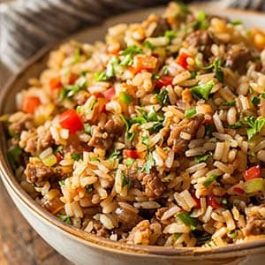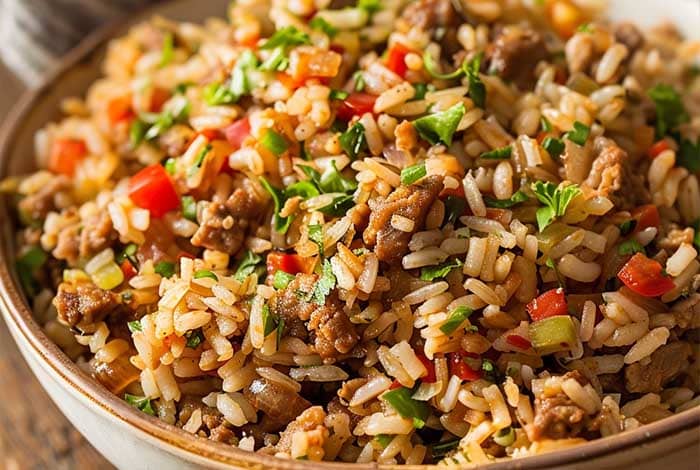Louisiana Dirty Rice is a quintessential dish that embodies the spirit and flavors of Southern cuisine. With roots deeply embedded in the culinary traditions of Louisiana, this dish is a testament to the rich cultural tapestry of the region. Originating from the Creole and Cajun communities, Dirty Rice has evolved from a simple, rustic meal to a beloved staple enjoyed by many. Its name, intriguing to those unfamiliar, hints at the unique blend of ingredients that give the rice its characteristic “dirty” appearance. Traditionally served as a side dish but hearty enough to stand alone as a main, Dirty Rice features prominently in family gatherings, festive celebrations, and everyday meals across the South. Its versatility and deeply comforting nature have cemented its place in the heart of Southern cuisine, making it a cherished dish that transcends generations.
What Makes Dirty Rice “Dirty”?
The “dirty” moniker of Louisiana Dirty Rice comes from the mix of finely chopped or ground meats and the Holy Trinity of Cajun and Creole cooking—onion, bell pepper, and celery—that are sautéed together, giving the white rice a “dirty” coloration. The inclusion of ground beef, pork, and often chicken livers, imparts a rich, complex flavor and a distinctive appearance that sets this dish apart from other rice dishes. The chicken livers, a traditional ingredient, are key to achieving the deep, earthy tones and full-bodied richness that Dirty Rice is known for. However, the dish’s adaptability means that it can also be made without livers, using substitutes like sausage or even seafood, to cater to different palates and preferences.
The Ingredients
Key Ingredients Overview
- Ground Meat: The foundation of Dirty Rice lies in its use of ground meats. Beef and pork offer richness, while chicken livers add a distinctive depth of flavor.
- The Holy Trinity: Central to many Louisiana dishes, the combination of diced onion, bell pepper, and celery provides a flavorful base that infuses the rice with traditional Southern aromas.
- Seasonings and Spices: A blend of chili powder, oregano, parsley, thyme, paprika, bay leaves, garlic, salt, pepper, and cayenne pepper creates a complex flavor profile that is both spicy and savory.
Variations Across Families and Regions
Every family in Louisiana has its own version of Dirty Rice, with recipes passed down through generations. While some stick to the traditional use of chicken livers, others incorporate modern twists like adding oysters or using bacon grease for additional flavor. These variations reflect the diverse culinary landscape of Louisiana and the personal preferences that contribute to the rich tapestry of Southern cooking.
Cooking Techniques
Traditional Cooking Methods
The traditional method of preparing Louisiana Dirty Rice involves a few essential steps that ensure its distinctive flavor and texture. The process begins with heating a large skillet or Dutch oven over medium-high heat. Ground meat—typically a combination of beef, pork, and chicken livers—is added to the pan and browned until fully cooked. This step is crucial for developing the deep, savory base that characterizes the dish.
Next, the Holy Trinity of Cajun and Creole cooking—finely diced onion, bell pepper, and celery—is sautéed in the same pan until the vegetables are soft and fragrant. This mixture forms the aromatic backbone of the dish. Seasonings, including chili powder, oregano, thyme, paprika, and cayenne, are then stirred in, infusing the meat and vegetables with a rich, complex flavor profile.
The final step involves folding cooked rice into the skillet, allowing it to absorb the flavorful juices and spices from the meat and vegetable mixture. The rice turns a “dirty” color as it soaks up the mixture, giving the dish its name. The result is a hearty, flavorful dish that’s ready to be served.
Modern Twists and Variations
For those seeking convenience without sacrificing flavor, modern cooking appliances like slow cookers and Instant Pots offer alternative methods for preparing Dirty Rice. In a slow cooker, all ingredients can be combined and set to cook on low for several hours, allowing the flavors to meld together slowly and develop depth. Instant Pot versions expedite the process, cooking Dirty Rice in a fraction of the time while still achieving a rich, savory taste. These modern methods provide flexibility for busy cooks, making it easier to enjoy this classic Southern dish any day of the week.
Serving and Pairing Suggestions
Louisiana Dirty Rice is a versatile dish that can be served in a variety of ways, making it a staple in Southern cuisine. As a main dish, it offers a hearty, satisfying meal, rich in flavors and textures. It can also be served as a side dish, complementing a wide range of proteins such as grilled chicken, pork chops, or fish. Additionally, Dirty Rice makes an excellent stuffing for vegetables like bell peppers or tomatoes, providing a flavorful twist on traditional stuffed recipes.
When it comes to pairing with other dishes, Dirty Rice goes well with many Southern favorites. Recommended accompaniments include:
- Cornbread: The sweetness of cornbread balances the spicy, savory flavors of Dirty Rice, making for a perfect combination.
- Okra: Whether fried, grilled, or stewed, okra adds a delightful texture and a touch of freshness to the meal.
- Collard Greens: The slight bitterness of collard greens complements the richness of Dirty Rice, rounding out the meal with a nutritious side.
These serving and pairing suggestions showcase the flexibility of Louisiana Dirty Rice, making it a beloved dish that fits seamlessly into a variety of meals and occasions.
Cultural and Regional Significance
Louisiana Dirty Rice holds a special place in the heart of Louisiana culture, serving as a culinary bridge between past and present. This dish is a staple at numerous gatherings, from casual weeknight dinners to significant celebrations and holidays like Mardi Gras and Thanksgiving. Its versatility and rich flavor profile make it a beloved choice for feeding a crowd, embodying the spirit of Southern hospitality and communal dining. Dirty Rice’s ability to adapt to various occasions and preferences showcases its integral role in Louisiana’s culinary landscape.
Across Louisiana, regional variations of Dirty Rice reflect the diverse culinary traditions of the state. For example, in Cajun regions, the dish might lean more heavily on spices and include a variety of meats, including wild game. In contrast, Creole versions may incorporate seafood and a broader array of seasonings, highlighting the blend of cultures that influence New Orleans and surrounding areas. These regional differences not only add to the richness of Louisiana’s culinary heritage but also allow individuals to connect with their community and family traditions through food.
FAQs
- What is the difference between Dirty Rice and Jambalaya? While both are iconic Louisiana rice dishes, Dirty Rice is typically made with ground meats and the “Holy Trinity” of onions, bell peppers, and celery, giving it a darker color. Jambalaya, on the other hand, includes a broader variety of meats and sometimes tomatoes, and it can be either red (Creole) or brown (Cajun).
- Can Dirty Rice be made vegetarian? Yes, Dirty Rice can be adapted for a vegetarian diet by substituting the meat with plant-based alternatives like lentils or mushrooms, which mimic the texture and richness of the traditional ingredients.
- Is Dirty Rice spicy? The spice level of Dirty Rice can vary according to personal preference. Traditional recipes include a blend of spices that offer warmth without overwhelming heat, but the dish can be easily adjusted to be milder or spicier.
- How long can you store Dirty Rice? Dirty Rice can be stored in the refrigerator for up to three days. For longer storage, it can be frozen in an airtight container for up to three months, making it a convenient make-ahead meal option.

Louisiana Dirty Rice Recipe
Equipment
- Large skillet or Dutch oven
- Wooden spoon
- Measuring cups and spoons
Ingredients
- 1 lb ground beef
- 1 lb ground pork or sausage
- ½ cup finely chopped chicken livers optional
- 1 large onion diced
- 1 green bell pepper diced
- 3 stalks celery diced
- 2 cloves garlic minced
- 2 cups chicken broth
- 1 ½ cups long-grain white rice cooked
- 1 tablespoon cooking oil
- 1 teaspoon paprika
- 1 teaspoon dried thyme
- ½ teaspoon cayenne pepper adjust to taste
- Salt and black pepper to taste
- 2 tablespoons chopped parsley for garnish
Instructions
- Prepare the Rice: Cook the rice according to package instructions and set aside.
- Brown the Meat: In a large skillet or Dutch oven, heat the oil over medium-high heat. Add the ground beef, pork, and optional chicken livers. Cook until browned, breaking up the meat with a spoon.
- Add the Vegetables: Stir in the onion, bell pepper, celery, and garlic. Cook until the vegetables are softened, about 5-7 minutes.
- Season: Add paprika, thyme, cayenne, salt, and pepper. Stir well to combine.
- Simmer: Pour in the chicken broth and bring to a simmer. Reduce heat and let cook for about 10 minutes, allowing the flavors to meld.
- Combine with Rice: Fold in the cooked rice until well combined with the meat and vegetable mixture. Cook for an additional 5 minutes, or until everything is heated through.
- Garnish and Serve: Remove from heat, garnish with chopped parsley, and serve warm
Notes
- Vegetarian Variation: For a vegetarian version, substitute the meats with a mix of lentils and finely chopped mushrooms. Use vegetable broth instead of chicken broth.
- Storage: Leftover Dirty Rice can be stored in an airtight container in the refrigerator for up to 3 days or frozen for up to 3 months. Reheat gently on the stove or in the microwave, adding a little broth or water if necessary to keep it moist.
- Spice Level: Adjust the amount of cayenne pepper according to your preference for heat.

